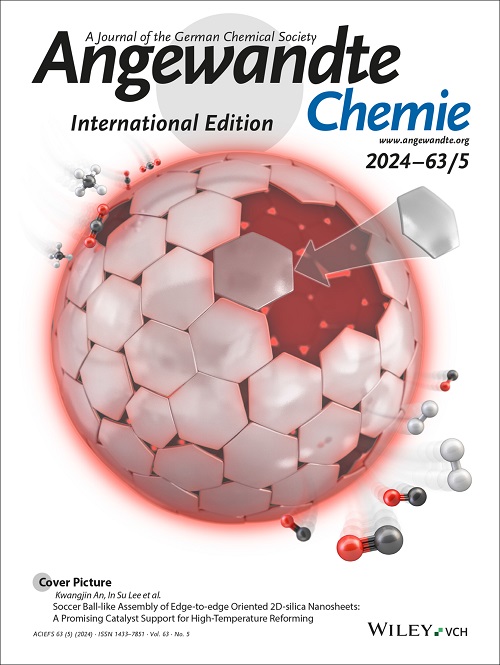Non-natural MUC1 Glycopeptide Homogeneous Cancer Vaccine with Enhanced Immunogenicity and Therapeutic Activity
IF 16.1
1区 化学
Q1 CHEMISTRY, MULTIDISCIPLINARY
引用次数: 0
Abstract
Glycopeptides derived from the glycoprotein mucin-1 (MUC1) have shown potential as tumor-associated antigens for cancer vaccine development. However, their low immunogenicity and non-selective conjugation to carriers present significant challenges for the clinical efficacy of MUC1-based vaccines. Here, we introduce a novel vaccine candidate based on a structure-guided design of an artificial antigen derived from MUC1 glycopeptide. This engineered antigen contains two non-natural amino acids and has an α-S-glycosidic bond, where sulfur replaces the conventional oxygen atom linking the peptide backbone to the sugar N-acetylgalactosamine. The glycopeptide is then specifically conjugated to the immunogenic protein carrier CRM197 (Cross-Reactive Material 197), a protein approved for human use. Conjugation involves selective reduction and re-bridging of a disulfide in CRM197, allowing the attachment of a single copy of MUC1. This strategy results in a chemically defined vaccine while maintaining both the structural integrity and immunogenicity of the protein carrier. The vaccine elicits a robust Th1-like immune response in mice and generates antibodies capable of recognizing human cancer cells expressing tumor-associated MUC1. When tested in mouse models of colon adenocarcinoma and pancreatic cancer, the vaccine is effective both as a prophylactic and therapeutic use, significantly delaying tumor growth. In therapeutic applications, improved outcomes were….具有增强免疫原性和治疗活性的非天然 MUC1 糖肽均质癌症疫苗
源自糖蛋白粘蛋白-1(MUC1)的糖肽已显示出作为肿瘤相关抗原开发癌症疫苗的潜力。然而,它们的低免疫原性和与载体的非选择性结合给基于 MUC1 的疫苗的临床疗效带来了巨大挑战。在此,我们介绍了一种新型候选疫苗,它是基于 MUC1 糖肽的人工抗原的结构指导设计。这种工程抗原含有两个非天然氨基酸,并具有α-S-糖苷键,其中硫取代了连接肽骨架和糖 N-乙酰半乳糖胺的传统氧原子。然后,糖肽与免疫原蛋白载体 CRM197(交叉反应材料 197)特异性结合,CRM197 是一种获准用于人体的蛋白质。共轭过程包括选择性还原和重新桥接 CRM197 中的二硫化物,使单个拷贝的 MUC1 得以附着。这种策略在保持蛋白载体的结构完整性和免疫原性的同时,还能产生一种化学定义的疫苗。这种疫苗能引起小鼠强烈的 Th1 类免疫反应,并产生能识别表达肿瘤相关 MUC1 的人类癌细胞的抗体。在结肠腺癌和胰腺癌小鼠模型中进行测试时,该疫苗在预防和治疗方面都很有效,能显著延缓肿瘤生长。在治疗应用中,....。
本文章由计算机程序翻译,如有差异,请以英文原文为准。
求助全文
约1分钟内获得全文
求助全文
来源期刊
CiteScore
26.60
自引率
6.60%
发文量
3549
审稿时长
1.5 months
期刊介绍:
Angewandte Chemie, a journal of the German Chemical Society (GDCh), maintains a leading position among scholarly journals in general chemistry with an impressive Impact Factor of 16.6 (2022 Journal Citation Reports, Clarivate, 2023). Published weekly in a reader-friendly format, it features new articles almost every day. Established in 1887, Angewandte Chemie is a prominent chemistry journal, offering a dynamic blend of Review-type articles, Highlights, Communications, and Research Articles on a weekly basis, making it unique in the field.

 求助内容:
求助内容: 应助结果提醒方式:
应助结果提醒方式:


